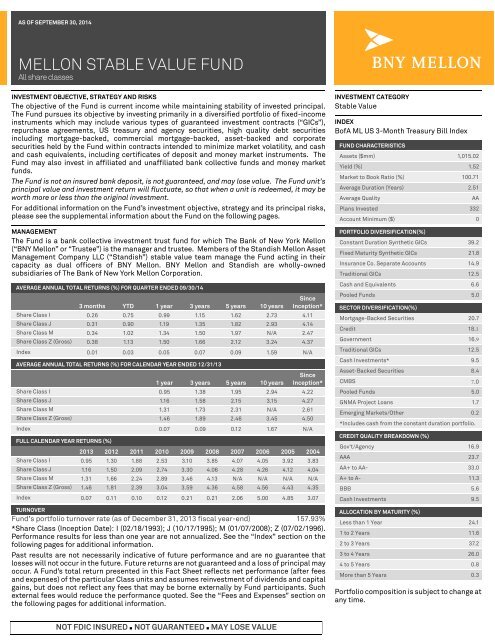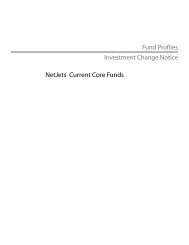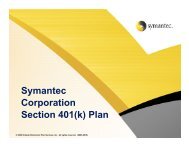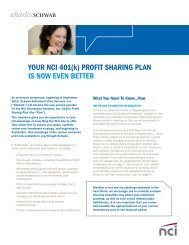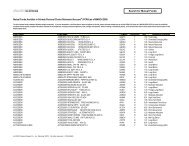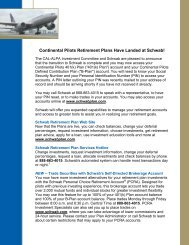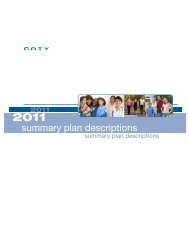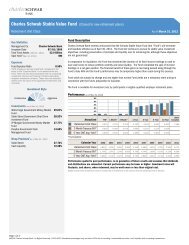MELLON STABLE VALUE FUND
Charles Schwab Stable Value Fund - Schwab Retirement Plan ...
Charles Schwab Stable Value Fund - Schwab Retirement Plan ...
- No tags were found...
Create successful ePaper yourself
Turn your PDF publications into a flip-book with our unique Google optimized e-Paper software.
AS OF SEPTEMBER 30, 2014<br />
<strong>MELLON</strong> <strong>STABLE</strong> <strong>VALUE</strong> <strong>FUND</strong><br />
All share classes<br />
INVESTMENT OBJECTIVE, STRATEGY AND RISKS<br />
The objective of the Fund is current income while maintaining stability of invested principal.<br />
The Fund pursues its objective by investing primarily in a diversified portfolio of fixed-income<br />
instruments which may include various types of guaranteed investment contracts (“GICs”),<br />
repurchase agreements, US treasury and agency securities, high quality debt securities<br />
including mortgage-backed, commercial mortgage-backed, asset-backed and corporate<br />
securities held by the Fund within contracts intended to minimize market volatility, and cash<br />
and cash equivalents, including certificates of deposit and money market instruments. The<br />
Fund may also invest in affiliated and unaffiliated bank collective funds and money market<br />
funds.<br />
The Fund is not an insured bank deposit, is not guaranteed, and may lose value. The Fund unit’s<br />
principal value and investment return will fluctuate, so that when a unit is redeemed, it may be<br />
worth more or less than the original investment.<br />
For additional information on the Fund’s investment objective, strategy and its principal risks,<br />
please see the supplemental information about the Fund on the following pages.<br />
MANAGEMENT<br />
The Fund is a bank collective investment trust fund for which The Bank of New York Mellon<br />
(“BNY Mellon” or “Trustee”) is the manager and trustee. Members of the Standish Mellon Asset<br />
Management Company LLC (“Standish”) stable value team manage the Fund acting in their<br />
capacity as dual officers of BNY Mellon. BNY Mellon and Standish are wholly-owned<br />
subsidiaries of The Bank of New York Mellon Corporation.<br />
AVERAGE ANNUAL TOTAL RETURNS (%) FOR QUARTER ENDED 09/30/14<br />
3 months YTD 1 year 3 years 5 years 10 years<br />
Since<br />
Inception*<br />
Share Class I 0.26 0.75 0.99 1.15 1.62 2.73 4.11<br />
Share Class J 0.31 0.90 1.19 1.35 1.82 2.93 4.14<br />
Share Class M 0.34 1.02 1.34 1.50 1.97 N/A 2.47<br />
Share Class Z (Gross) 0.38 1.13 1.50 1.66 2.12 3.24 4.37<br />
Index 0.01 0.03 0.05 0.07 0.09 1.59 N/A<br />
AVERAGE ANNUAL TOTAL RETURNS (%) FOR CALENDAR YEAR ENDED 12/31/13<br />
1 year 3 years 5 years 10 years<br />
Since<br />
Inception*<br />
Share Class I 0.95 1.38 1.95 2.94 4.22<br />
Share Class J 1.16 1.58 2.15 3.15 4.27<br />
Share Class M 1.31 1.73 2.31 N/A 2.61<br />
Share Class Z (Gross) 1.46 1.89 2.46 3.45 4.50<br />
Index 0.07 0.09 0.12 1.67 N/A<br />
FULL CALENDAR YEAR RETURNS (%)<br />
2013 2012 2011 2010 2009 2008 2007 2006 2005 2004<br />
Share Class I 0.95 1.30 1.88 2.53 3.10 3.85 4.07 4.05 3.92 3.83<br />
Share Class J 1.16 1.50 2.09 2.74 3.30 4.06 4.28 4.26 4.12 4.04<br />
Share Class M 1.31 1.66 2.24 2.89 3.46 4.13 N/A N/A N/A N/A<br />
Share Class Z (Gross) 1.46 1.81 2.39 3.04 3.59 4.36 4.58 4.56 4.43 4.35<br />
Index 0.07 0.11 0.10 0.12 0.21 0.21 2.06 5.00 4.85 3.07<br />
TURNOVER<br />
Fund’s portfolio turnover rate (as of December 31, 2013 fiscal year-end) 157.93%<br />
*Share Class (Inception Date): I (02/18/1993); J (10/17/1995); M (01/07/2008); Z (07/02/1996).<br />
Performance results for less than one year are not annualized. See the “Index” section on the<br />
following pages for additional information.<br />
Past results are not necessarily indicative of future performance and are no guarantee that<br />
losses will not occur in the future. Future returns are not guaranteed and a loss of principal may<br />
occur. A Fund’s total return presented in this Fact Sheet reflects net performance (after fees<br />
and expenses) of the particular Class units and assumes reinvestment of dividends and capital<br />
gains, but does not reflect any fees that may be borne externally by Fund participants. Such<br />
external fees would reduce the performance quoted. See the “Fees and Expenses” section on<br />
the following pages for additional information.<br />
INVESTMENT CATEGORY<br />
Stable Value<br />
INDEX<br />
BofA ML US 3-Month Treasury Bill Index<br />
<strong>FUND</strong> CHARACTERISTICS<br />
Assets ($mm) 1,015.02<br />
Yield (%) 1.52<br />
Market to Book Ratio (%) 100.71<br />
Average Duration (Years) 2.51<br />
Average Quality<br />
Portfolio composition is subject to change at<br />
any time.<br />
AA<br />
Plans Invested 332<br />
Account Minimum ($) 0<br />
PORTFOLIO DIVERSIFICATION(%)<br />
Constant Duration Synthetic GICs 39.2<br />
Fixed Maturity Synthetic GICs 21.8<br />
Insurance Co. Separate Accounts 14.9<br />
Traditional GICs 12.5<br />
Cash and Equivalents 6.6<br />
Pooled Funds 5.0<br />
SECTOR DIVERSIFICATION(%)<br />
Mortgage-Backed Securities 20.7<br />
Credit 18.1<br />
Government 16.9<br />
Traditional GICs 12.5<br />
Cash Investments* 9.5<br />
Asset-Backed Securities 8.4<br />
CMBS<br />
Pooled Funds 5.0<br />
GNMA Project Loans 1.7<br />
Emerging Markets/Other 0.2<br />
*Includes cash from the constant duration portfolio.<br />
CREDIT QUALITY BREAKDOWN (%)<br />
Gov't/Agency 16.9<br />
AAA 23.7<br />
AA+ to AA- 33.0<br />
A+ to A- 11.3<br />
BBB 5.6<br />
Cash Investments 9.5<br />
ALLOCATION BY MATURITY (%)<br />
7.0<br />
Less than 1 Year 24.1<br />
1 to 2 Years 11.6<br />
2 to 3 Years 37.2<br />
3 to 4 Years 26.0<br />
4 to 5 Years 0.8<br />
More than 5 Years 0.3<br />
NOT FDIC INSURED • NOT GUARANTEED • MAY LOSE <strong>VALUE</strong>
Mellon Stable Value Fund<br />
EXPENSE INFORMATION<br />
Fees and expenses are only one of several factors to consider when<br />
making investment decisions. Following are the expenses you would<br />
incur as an investor in the Fund. The expenses are provided as a<br />
percentage of the average net asset value of the Fund, and as a dollar<br />
amount of expenses assuming a one-year investment of $1,000 with<br />
no change in the Fund’s performance. Your actual costs and returns<br />
will vary. See the “Fees and Expenses” section for additional<br />
information.<br />
TOTAL ANNUAL <strong>FUND</strong> OPERATING EXPENSES<br />
Class Z – zero fee share class (billed outside fund) 0.26%<br />
Class Z $2.60<br />
Class M – 15 basis point share class 0.41%<br />
Class M $4.10<br />
Class Ja – 30 basis point share class, 15 basis points to the Trustee<br />
and 15 basis points to the service provider. 0.56%<br />
Class Ja $5.60<br />
Class Jb – 30 basis point share class, 20 basis points to the Trustee<br />
and 10 basis points to the service provider. 0.56%<br />
Class Jb $5.60<br />
Class Ia 50 basis point share class, 15 basis points to the Trustee<br />
and 35 basis points to the service provider. 0.76%<br />
Class Ia $7.60<br />
Class Ib 50 basis point share class, 20 basis points to the Trustee<br />
and 30 basis points to the service provider. 0.76%<br />
Class Ib $7.60<br />
<br />
The Fund's expense ratio and performance information includes the<br />
actual outside audit expenses charged to the Fund. The Fund’s<br />
expense ratio and performance also include the underlying product<br />
fees associated with synthetic wrap contracts of 15 basis points,<br />
insurance company separate account, pooled fund and underlying<br />
asset management fees of fees of 11 basis points, which are<br />
embedded in those contracts’ crediting rates. These fees are<br />
approximate and may vary. The expense ratio and performance for<br />
Class Z Shares do not include external management fees that the<br />
Fund charges to the Plan.<br />
Please note that this presentation does not comply with all of the<br />
disclosure requirements for an ERISA “section 404(c) plan,” as<br />
described in the Department of Labor regulations under section<br />
404(c), nor does it contain all of the disclosure required by Rule 404a-<br />
5. Plan sponsors intending to comply with those regulations will need<br />
to provide the plan participants with additional information. The<br />
information provided in this presentation does not constitute<br />
individual investment advice for a participant or investor, is only<br />
informational in nature and should not be used by a participant or<br />
investor as a primary basis for making an investment decision.<br />
Participants should consult their financial adviser to determine their<br />
investment risk and tolerance, and evaluate if the Fund is suitable for<br />
their retirement needs.<br />
SHARE CLASS IDENTIFIER<br />
Share class Cusip Sub classes<br />
Z 58552T106 N/A<br />
M 58552T205 N/A<br />
J 58552T304 a and b<br />
I 58552T403 a and b<br />
TOP 5 CONTRACT ISSUERS (%)<br />
Prudential 14.9<br />
American General Life Insurance Company 14.5<br />
Pacific Life 14.4<br />
Athene Annuity & Life Company 11.9<br />
New York Life 8.9<br />
THE <strong>FUND</strong>, ITS OBJECTIVE, ITS PRINCIPAL INVESTMENT STRATEGY<br />
AND PRINCIPAL RISKS<br />
The objective of the Fund is current income while maintaining<br />
stability of invested principal. The Fund pursues its objective by<br />
investing primarily in a diversified portfolio of fixed-income<br />
instruments which may include traditional guaranteed investment<br />
contracts (“GICs”) (obligations of creditworthy life insurance<br />
companies), separate account GICs, synthetic GICs (high-quality debt<br />
securities including mortgage-backed, commercial mortgagebacked,<br />
asset-backed and corporate securities held by the Fund<br />
within contracts that are intended to minimize market volatility),<br />
variable rate GICs, repurchase agreements, US treasury and agency<br />
securities, and cash and cash equivalents, including certificates of<br />
deposit and money market instruments. The Fund may also invest in<br />
a collective fund or group trust (including but not limited to one<br />
maintained by BNY Mellon or its affiliate) that invests in such fixed<br />
income instruments, and the terms of such collective fund or group<br />
trust are hereby incorporated by reference in the Fund and shall be<br />
part of the Fund. A portion of the Fund may be invested in one or more<br />
money market mutual funds sponsored, managed, advised,<br />
subadvised, administered or distributed by a parent, subsidiary or<br />
affiliate of BNY Mellon to the extent consistent with ERISA. Such an<br />
investment may include units of a fixed income fund that are held by<br />
the Fund as part of a synthetic GIC.<br />
No investment contract in which the Fund invests will have a duration<br />
of more than six years from the date of issuance. The Fund will<br />
operate with a weighted average duration selected by BNY Mellon, in<br />
its capacity as Trustee of the Fund from time to time, but such<br />
weighted average duration generally will average between 1.0 and 3.0<br />
years. In order for a GIC to be accepted into the Fund at the time of<br />
the investment, the issuer of the GIC must be rated on The Stable<br />
Value Issuer Universe, comprised of creditworthy insurance<br />
companies and commercial banks that are approved by BNY Mellon<br />
for purchase of GICs and synthetic GICs in the Fund.<br />
The Fund will be diversified, will not concentrate in securities of<br />
issuers of a particular industry or group of industries, and will not<br />
participate in securities lending directly, but may invest a portion of<br />
its assets in underlying collective investment funds that engage in<br />
securities lending.<br />
SUMMARY OF PRINCIPAL RISKS<br />
Depending on the Fund’s investment allocations, the Fund is exposed<br />
to varying degrees of the following principal investment risks, each of<br />
which may adversely affect the Fund’s unit value, its performance<br />
and the ability to achieve its investment objective:<br />
Asset-backed securities risk. General downturns in the economy<br />
could cause the value of asset-backed securities to fall. In addition,<br />
asset-backed securities present certain risks that are not presented<br />
by mortgage-backed securities. Primarily, these securities may<br />
provide the Fund with a less effective security interest in the related<br />
collateral than do mortgage-backed securities. Therefore, there is the<br />
possibility that recoveries on the underlying collateral may not, in<br />
some cases, be available to support payments on these securities.<br />
Call risk. Some bonds give the issuer the option to call, or redeem, the<br />
bonds before their maturity date. If an issuer “calls” its bond during a<br />
time of declining interest rates, the Fund might have to reinvest the<br />
proceeds in an investment offering a lower yield, and therefore might<br />
not benefit from any increase in value as a result of declining interest<br />
rates. During periods of market illiquidity or rising interest rates,<br />
prices of “callable” issues are subject to increased price fluctuation.
Mellon Stable Value Fund<br />
Counterparty risk. The risk that counterparties in a repurchase<br />
agreement could fail to honor the terms of its agreement.<br />
Credit risk. Failure of an issuer to make timely interest or principal<br />
payments, or a decline or perception of a decline in the credit quality<br />
of a security, can cause the security’s price to fall, potentially<br />
lowering the value of your investment. Although the Fund invests only<br />
in high quality debt securities, any of the Fund’s holdings could have<br />
its credit rating downgraded or could default. The credit quality of the<br />
securities held by the Fund can change rapidly in certain market<br />
environments, and the default of a single holding could have the<br />
potential to cause significant deterioration of the value of your<br />
investment.<br />
GICs. GICs are general obligations of the issuing company and may or<br />
may not be backed by insurance or a guaranty provided by a third<br />
party. If the issuer defaults, remedies generally available to creditors<br />
should be available to the Fund. However, applicable insurance and<br />
bank regulations may affect remedies available to holders of GICs. In<br />
addition, if bankruptcy or insolvency proceedings are commenced<br />
with respect to the issuer, realization on a GIC may be delayed or<br />
limited. Synthetic GICs seek to provide certain protections from the<br />
credit risk associated with a traditional GIC instrument. However,<br />
synthetic GICs may be subject to other types of risks, including cash<br />
flow risk and interest rate risk. Variable Rate GICs have interest rates<br />
that fluctuate at designated intervals based on a designated index.<br />
As a general rule, GICs and similar instruments are not assignable or<br />
transferable without the permission of the issuing insurance<br />
companies. For this reason, an active secondary market in GICs and<br />
similar instruments does not currently exist nor is an active<br />
secondary market expected to develop. In addition, GICs can<br />
generally be redeemed before maturity only at a substantial discount<br />
or penalty. As a result, GICs and similar instruments are usually<br />
considered to be illiquid investments. Accordingly, the Fund’s<br />
governing instrument sets forth certain restrictions and conditions<br />
that may apply to withdrawals from the Fund.<br />
Government securities risk. Not all obligations of the US government,<br />
its agencies and instrumentalities are backed by the full faith and<br />
credit of the US Treasury. Some obligations are backed only by the<br />
credit of the issuing agency or instrumentality, and in some cases<br />
there may be some risk of default by the issuer. Any guarantee by the<br />
US government or its agencies or instrumentalities of a security held<br />
by the Fund does not apply to the market value of such security. A<br />
security backed by the US Treasury or the full faith and credit of the<br />
United States is guaranteed only as to the timely payment of interest<br />
and principal when held to maturity. In addition, because many types<br />
of US government securities trade actively outside the United States,<br />
their prices may rise and fall as changes in global economic<br />
conditions affect the demand for these securities.<br />
Indexing strategy risk. The Fund may use an indexing strategy for a<br />
portion of its assets by investing in underlying collective investment<br />
funds that seek to track the investments or performance of an index.<br />
It does not attempt to manage market volatility, use defensive<br />
strategies or reduce the effects of any long-term periods of poor<br />
index performance. The correlation between Fund and index<br />
performance may be affected by the Fund’s expenses and use of<br />
sampling techniques, changes in securities markets, changes in the<br />
composition of the index and the timing of purchases and sales.<br />
Interest rate risk. Prices of bonds, including mortgage-related and<br />
other debt securities, tend to move inversely with changes in interest<br />
rates. Typically, a rise in rates will adversely affect bond prices and,<br />
accordingly, the value of your account. The longer the effective<br />
maturity and duration of the Fund’s portfolio, the more the value of<br />
your investment is likely to react to interest rates. Mortgage-related<br />
securities can have a different interest rate sensitivity than other<br />
bonds, however, because of prepayments and other factors. The<br />
longer the effective maturity and duration of the Fund’s portfolio, the<br />
more the value of your investment is likely to react to interest rates.<br />
Issuer risk. The value of a security may decline for a number of<br />
reasons which directly relate to the issuer, such as management<br />
performance, financial leverage and reduced demand for the issuer’s<br />
products or services.<br />
Liquidity risk. When there is little or no active trading market for<br />
specific types of securities, it can become more difficult to sell the<br />
securities at or near their perceived value. In such a market, the value<br />
of such securities and the value of your investment may fall<br />
dramatically, even during periods of declining interest rates. Liquidity<br />
risk also exists when a particular derivative instrument is difficult to<br />
purchase or sell. If a derivative transaction is particularly large or if<br />
the relevant market is illiquid (as is the case with many privately<br />
negotiated derivatives), it may not be possible to initiate a transaction<br />
or liquidate a position at an advantageous time or price.<br />
Market and credit risk. Ginnie Maes and other securities backed by<br />
the full faith and credit of the United States are guaranteed only as to<br />
the timely payment of interest and principal when held to maturity.<br />
The market prices for such securities are not guaranteed and will<br />
fluctuate. Privately issued mortgage-related securities also are<br />
subject to credit risks associated with the underlying mortgage<br />
properties. These securities may be more volatile and less liquid than<br />
more traditional, government backed debt securities.<br />
Market risk. The market value of a security may decline due to general<br />
market conditions that are not specifically related to a particular<br />
company, such as real or perceived adverse economic conditions,<br />
changes in the outlook for corporate earnings, changes in interest or<br />
currency rates or adverse investor sentiment generally. A security’s<br />
market value also may decline because of factors that affect a<br />
particular industry or industries, such as labor shortages or<br />
increased production costs and competitive conditions within an<br />
industry.<br />
Prepayment and extension risk. When interest rates fall, the principal<br />
on mortgage-backed and certain asset-backed securities may be<br />
prepaid. The loss of higher yielding underlying mortgages and the<br />
reinvestment of proceeds at lower interest rates can reduce the<br />
Fund’s potential price gain in response to falling interest rates and<br />
reduce the value of your investment. When interest rates rise, the<br />
effective duration of the Fund’s mortgage-related and other assetbacked<br />
securities may lengthen due to a drop in prepayments of the<br />
underlying mortgages or other assets. This is known as extension risk<br />
and would increase the Fund’s sensitivity to rising interest rates and<br />
its potential for price declines.<br />
Sector Risk. A substantial part of the Fund’s investments may be<br />
issued or wrapped by insurance companies or companies with similar<br />
characteristics. As a result, the Fund will be more susceptible to any<br />
economic, business, political or other developments that generally<br />
affect these entities. Developments affecting insurance companies<br />
or companies with similar characteristics might include changes in<br />
interest rates, changes in economic cycle affecting credit losses,<br />
adverse claims experience, regulatory changes and industry<br />
consolidation.<br />
US Treasury securities risk. A security backed by the US Treasury or<br />
the full faith and credit of the United States is guaranteed only as to<br />
the timely payment of interest and principal when held to maturity,<br />
but the market prices for such securities are not guaranteed and will<br />
fluctuate. Because US Treasury securities trade actively outside the<br />
United States, their prices may rise and fall as changes in global<br />
economic conditions affect the demand for these securities.<br />
Additional Risks. As a bank-maintained collective investment fund,<br />
the Fund and its units are not registered under federal and state<br />
securities laws in reliance upon applicable exemptions. Because the<br />
Fund is not a mutual fund, it is governed by different regulations,<br />
restrictions and disclosure requirements. For example, the Fund is<br />
subject to banking and tax regulations which, among other things,<br />
limit participation to certain eligible qualified retirement plans (stock<br />
bonus, retirement, pension and profit sharing accounts) and<br />
government plans where The Bank of New York Mellon or an affiliate<br />
is a trustee, investment manager, custodian or directed agent.
Mellon Stable Value Fund<br />
As is the case with bank sponsored collective funds, the Fund is not a<br />
deposit of, and is not insured or guaranteed by, any bank, financial<br />
institution, the FDIC or any other government agency, and participants<br />
may lose money. Also, a Fund unit's principal value and investment<br />
return will fluctuate, so that when a unit is redeemed, it may be worth<br />
more or less than the original investment.<br />
FEES AND EXPENSES<br />
The Fund has been established with four share classes, of which two<br />
have sub-classes. Each class or sub-class of units of the Fund will be<br />
charged such fees and expenses as are permitted by the Declaration<br />
of Trust, and are subject to change. Subject to acceptance of<br />
investments by the Trustee, each plan sponsor must determine which<br />
class or sub-class its plan will purchase based on the plan sponsor’s<br />
evaluation of the fee charged, services provided to the plan and the<br />
amount of the fee to be paid by the Trustee to the plan’s service<br />
provider. The Trustee may pay a portion of the fees described below in<br />
this section to a service provider of a participating plan for services<br />
rendered to such plan, which will serve to reduce direct plan expense.<br />
Participating plans may contact their service providers to determine<br />
whether the service provider receives such payments, and if so, the<br />
amount of such payment as it relates to the plan. The Trustee may in<br />
its discretion and with prior notice to the sponsors of affected plans<br />
from time to time add, delete, amend or otherwise modify a class or<br />
sub-class of units of the Fund, and will only be obligated to notify the<br />
current unitholders in the affected class or sub-class.<br />
Class Z: Units in Class Z will be offered gross of fees and will not<br />
include a management fee charge. The management fee will be<br />
charged to the unit holder at a mutually agreed upon rate at the<br />
account level.<br />
Class M: The asset based fee will be 15 basis points and retained by<br />
the Trustee for administrative, custody and investment management<br />
services. No portion of this fee may be used by the defined<br />
contribution plan sponsor to offset plan expenses.<br />
Class J: The asset based fee will be 30 basis points, of which a portion<br />
will be retained by the Trustee for administrative, custody and<br />
investment management services, and the rest will be paid to the<br />
service provider and may be used by the defined contribution plan<br />
sponsor to offset plan expenses, such as recordkeeping or other third<br />
party administrator charges.<br />
Sub-Class Ja –15 basis points each to Trustee and service provider.<br />
Sub-Class Jb - 20 basis points to Trustee and 10 basis points to the<br />
service provider.<br />
Class I: The asset based fee will be 50 basis points, of which a portion<br />
will be retained by the Trustee for administrative, custody and<br />
investment management services, and the rest will be paid to the<br />
service provider and may be used by the defined contribution plan<br />
sponsor to offset plan expenses, such as recordkeeping or other third<br />
party administrator charges.<br />
Sub-Class Ia – Of the 50 basis points, 15 basis points to the Trustee<br />
and 35 basis points to the service provider.<br />
Sub-Class Ib - Of the 50 basis points, 20 basis points to the Trustee<br />
and 30 basis points to the service provider.<br />
PERFORMANCE<br />
The Fund’s performance data represents past performance and<br />
should not be considered indicative of how the Fund will perform in<br />
the future. You should not assume that future investment decisions<br />
will be profitable or will equal past investment performance. The<br />
Fund does not promise or guarantee that its performance will achieve<br />
a participant’s objective or retirement needs. Fund portfolio<br />
statistics and asset allocations change over time. Performance<br />
results for less than one year are not annualized. Many factors affect<br />
performance including changes in market conditions and interest<br />
rates and changes in response to other economic, political, or<br />
financial developments.<br />
INDEX<br />
The Fund’s performance is compared to an index described below. An<br />
index does not incur management fees, costs, and expenses, and<br />
cannot be invested in directly. An index is an unmanaged portfolio of<br />
specified securities. A Fund’s portfolio may differ significantly from<br />
the securities in the index.<br />
The BofA ML US 3-Month Treasury Bill Index is comprised of a single<br />
issue purchased at the beginning of the month and held for a full<br />
month. At the end of the month that issue is sold and rolled into a<br />
newly selected issue. The issue selected at each month-end<br />
rebalancing is the outstanding Treasury Bill that matures closest to,<br />
but not beyond, three months from the rebalancing date. To qualify for<br />
selection, an issue must have settled on or before the month-end<br />
rebalancing date. While the index will often hold the Treasury Bill<br />
issued at the most recent 3-month auction, it is also possible for a<br />
seasoned 6-month Bill to be selected. Any indices are trademarks<br />
used for comparative purposes only. None of the owners of the<br />
trademarks sponsor, endorse, sell or promote the Fund, or make any<br />
representation regarding the advisability of investing in the products<br />
or strategies described. Redistribution of this information may be<br />
prohibited by the terms of the license.<br />
RESTRICTIONS ON PURCHASES OR REDEMPTIONS<br />
Participants in a plan or trust invested in this Fund are prohibited<br />
from directing investments into a competing fund without first<br />
investing in a non-competing fund for at least ninety (90) days. A noncompeting<br />
fund is any fund that is not a competing fund. A competing<br />
fund includes a money market fund, bank deposit, GIC, short-term<br />
bond fund, self-directed brokerage account or other fixed income<br />
investment vehicle whose average duration is three and one half<br />
years or less. Employer-directed transfers and withdrawals may be<br />
made subject to the provisions of the Declaration of Trust, including<br />
any notice requirements. However, BNY Mellon may, in its sole<br />
discretion, defer payment of withdrawals proceeds over such period<br />
of time, generally not to exceed twelve (12) months (subject to<br />
administrative considerations and compliance with the terms of any<br />
investment contract purchased by the Fund), as BNY Mellon may<br />
determine is necessary for a fair and orderly liquidation of all or a<br />
portion of the assets comprising the Fund, or may, if a particular plan<br />
or trust consents in writing, effect the withdrawal but reduce the<br />
value of the units being withdrawn by the adjustment in value of<br />
investment contracts held by the Fund created by the withdrawal.<br />
In addition, BNY Mellon may suspend the valuation of units of any<br />
class or the right to make purchases and redemptions of units of any<br />
class at any time in its sole discretion under circumstances described<br />
in the Declaration of Trust, including when such suspension is in the<br />
best interests of the class or the Fund unitholders, or is necessary or<br />
advisable in order to accord fair and equitable treatment to all Fund<br />
unitholders.<br />
CONTACT INFORMATION<br />
If you are an investor in the Fund and would like more information,<br />
contact BNY Mellon toll free at 877-499-4136 or your benefits<br />
administration department. For marketing information please<br />
contact Julie Carney at jcarney@standish.com.


